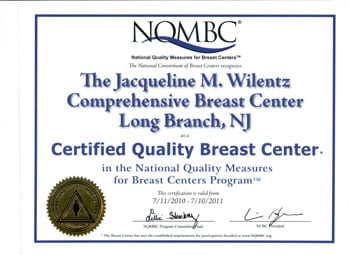Breast Imaging Advance
BSGI technology goes beyond mammograms to show metabolic activity in breast tissue.

If your diagnostIc mammogram is unclear or your doctor needs more information, there’s now another imaging technology he or she can turn to to identify cancerous lesions in the breast. It’s called breast-specific gamma imaging (BSGI), and it’s available at Monmouth Medical center’s Jacqueline M. Wilentz comprehensive Breast Center.
Breast-specific gamma imaging (BSGI) is a molecular breast imaging technology that helps diagnose breast cancer by highlighting the metabolic activity of breast lesions. It’s particularly beneficial to women who have had a questionable mammogram, are at high risk for breast cancer, have dense breast tissue or implants, have scars from previous biopsies, or are being monitored for breast cancer reoccurrence. approved by the food and drug administration, BSGI has been performed on more than 80,000 patients in both hospitals and private imaging centers across the country.
“BSGI is a valuable tool following a questionable mammogram when further evaluation is needed,” says Debra Camal, M.D., a surgeon who is medical director of the Wilentz center. It’s especially helpful when patients have multiple or suspicious lesions, or when women newly diagnosed with breast cancer require preoperative evaluation.”
During a BSGI procedure, a small amount of tracing agent is delivered to the patient and absorbed by the cells in the body. The agent emits visible gamma rays, which are detected by a special high-resolution camera and translated into a digital image of the breast. due to the higher metabolic activity of cancerous cells, these cells absorb a greater amount of the tracing agent and are revealed as “dark spots.”
By viewing these dark spots of concentrated radio- active material, radiologists can identify where cells are suspiciously active. These areas indicate the possibility of a cancerous or otherwise high-risk lesion.
Whereas other tests, such as mammography and ultrasound, create images of the physical structure of the breast, BSGI captures the actual cellular function of the breast tissue.
Jorge Pardes, M.D., radiologist and director of breast imaging at the Jacqueline M. Wilentz Comprehensive Breast Center, says BSGI can be used on high-risk breast cancer patients when breast MRI cannot be performed. It can also see lesions in very dense tissue, while providing multiple angle views for better diagnosis.
“The result is quicker, more accurate detection of breast cancer than with mammography alone,” says Dr. Pardes.
New satellite location for a much-honored center
This fall, in Colts Neck, Monmouth Medical Center’s Jacqueline M. Wilentz Comprehensive Breast Center opened its first satellite location at 310 Route 34.
Introduced in 1994 at the main campus in long Branch, the Wilentz Center brings together all preventive, diagnostic, treatment, rehabilitation, psychosocial and educational services for women concerned about their breast health. the new facility’s introduction came in the wake of two honors for the original wilentz Center:
-
The publication Imaging Technology News recognized the center as among the “Top Five Women’s Imaging Centers for 2010” for its “achievements in innovation, operational efficiency, customer service and teamwork.”
-
The National Accreditation Program for Breast Centers, administered by the american College of Surgeons, granted the center a three-year full accreditation.

